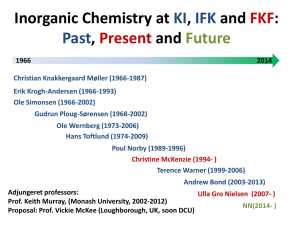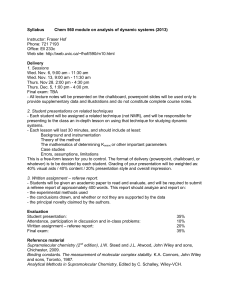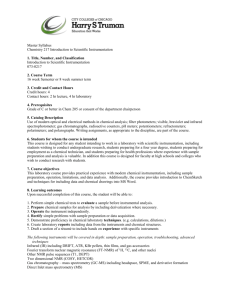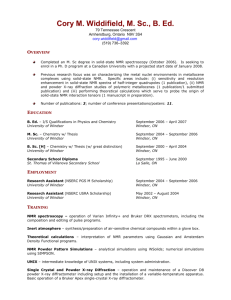clicking here
advertisement
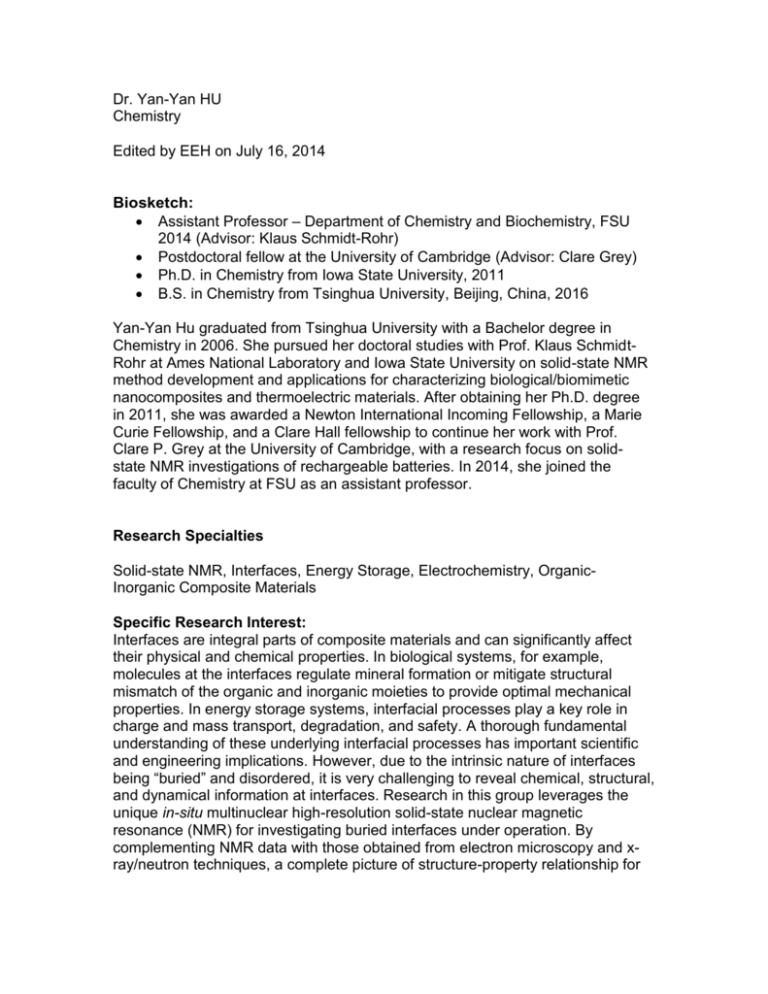
Dr. Yan-Yan HU Chemistry Edited by EEH on July 16, 2014 Biosketch: Assistant Professor – Department of Chemistry and Biochemistry, FSU 2014 (Advisor: Klaus Schmidt-Rohr) Postdoctoral fellow at the University of Cambridge (Advisor: Clare Grey) Ph.D. in Chemistry from Iowa State University, 2011 B.S. in Chemistry from Tsinghua University, Beijing, China, 2016 Yan-Yan Hu graduated from Tsinghua University with a Bachelor degree in Chemistry in 2006. She pursued her doctoral studies with Prof. Klaus SchmidtRohr at Ames National Laboratory and Iowa State University on solid-state NMR method development and applications for characterizing biological/biomimetic nanocomposites and thermoelectric materials. After obtaining her Ph.D. degree in 2011, she was awarded a Newton International Incoming Fellowship, a Marie Curie Fellowship, and a Clare Hall fellowship to continue her work with Prof. Clare P. Grey at the University of Cambridge, with a research focus on solidstate NMR investigations of rechargeable batteries. In 2014, she joined the faculty of Chemistry at FSU as an assistant professor. Research Specialties Solid-state NMR, Interfaces, Energy Storage, Electrochemistry, OrganicInorganic Composite Materials Specific Research Interest: Interfaces are integral parts of composite materials and can significantly affect their physical and chemical properties. In biological systems, for example, molecules at the interfaces regulate mineral formation or mitigate structural mismatch of the organic and inorganic moieties to provide optimal mechanical properties. In energy storage systems, interfacial processes play a key role in charge and mass transport, degradation, and safety. A thorough fundamental understanding of these underlying interfacial processes has important scientific and engineering implications. However, due to the intrinsic nature of interfaces being “buried” and disordered, it is very challenging to reveal chemical, structural, and dynamical information at interfaces. Research in this group leverages the unique in-situ multinuclear high-resolution solid-state nuclear magnetic resonance (NMR) for investigating buried interfaces under operation. By complementing NMR data with those obtained from electron microscopy and xray/neutron techniques, a complete picture of structure-property relationship for the interfaces of multilayer functional structures can be established. Specific research interests include: 1. Energy Materials. Efficient use of intermittently generated renewable energy sources, such as wind and solar, requires the development of advanced energy storage technologies. Rechargeable batteries are one of the leading energy storage technologies, widely employed in portable electronics and electric vehicles. However, severe degradation and safety issues have hindered further improvement towards high energy density, low cost, and long shelf life. One major cause of degradation and unsafety is the formation of non-stable solidelectrolyte-interphases (SEIs) from irreversible electrolyte decomposition at the battery electrode surface. Systematic studies on the SEIs in this group can reveal the details of degradation mechanisms, with which mitigation strategies such as electrolyte additives and surface engineering can be implemented and evaluated. Similar research can also be extended to other energy conversion storage systems including fuel cells, capacitors, solar cells, and sensors, etc. 2. Biological/Biomimetic Composite Materials. Inorganic-organic nanocomposites are prevalent in nature, including bones, teeth, shells, etc. This exemplary combination confers necessary biological functions, affords optimal mechanical properties, and/or produces exquisite designs. Interfaces play critical roles in reconciling the interplays between the organic moieties and minerals to achieve synergistic effects. The chemical composition and atomic structures of interfaces in biological composite materials can be studied with solid-state NMR along with complementary techniques, and the knowledge obtained can be applied to facilitate the fabrication of biomimetic nanocomposites that can be used in energy conversion and storage devices, sensors, or for biomedical applications. 3. Development and Applications of New NMR Characterization Techniques. Many systems that operate in non-equilibrium conditions, e.g., rechargeable lithium-ion batteries, require in situ characterization to follow the reaction processes in real time. Advanced in situ solid-state NMR techniques, including probe hardware and pulse sequences, are being developed in collaboration with scientists at NHMFL. Advanced sensitivity enhancement techniques, e.g. Dynamic Nuclear Polarization (DNP), are particularly being explored as a new technique to characterize functional materials containing low natural abundance and low, or samples with limited quantities.
